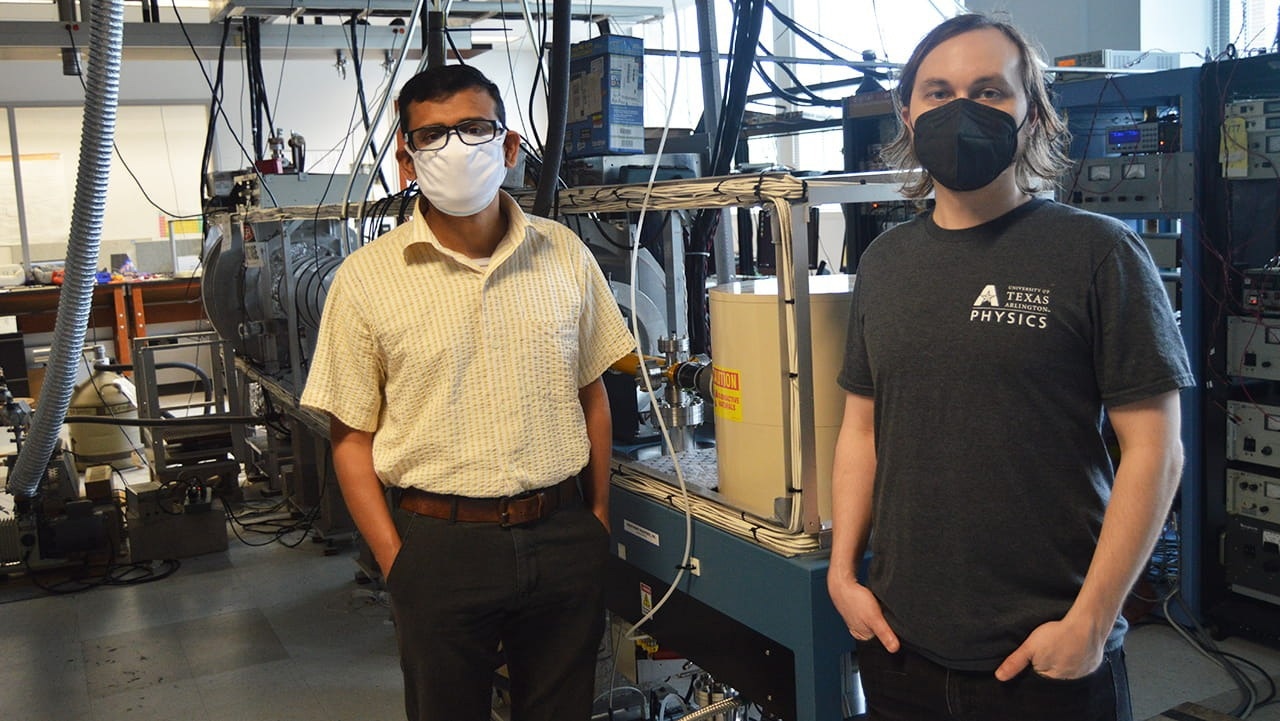Reviewed by Alex SmithNov 14 2022
Researchers at The University of Texas at Arlington have created a brand-new method for measuring the properties of the topmost atomic layer of materials without taking into account data from the deeper layers.
 Varghese Chirayath, left, and Alex Fairchild. Image Credit: The University of Texas at Arlington
Varghese Chirayath, left, and Alex Fairchild. Image Credit: The University of Texas at Arlington
The auger-mediated positron sticking (AMPS) technique was used by researchers from the Positron Lab at the University of Texas at Arlington to create a novel spectroscopic instrument for selectively measuring the electronic structure of materials’ surfaces.
The new method is described in a recent paper in the journal Physical Review Letters (PRL).
Additionally, a Viewpoint article explaining the significance of the paper to the field was published in the online journal Physics with the title “Spectroscopy That Doesn’t Scratch the Surface.” PRL editors commission viewpoint articles for papers they think will generate significant interest.
The study’s lead author is postdoctoral researcher Alex Fairchild from the Positron Lab. Co-authors include Ali Koymen, a Professor of Physics, Randall Gladen, a Postdoctoral Researcher, Varghese Chirayath, an Assistant Professor of Research, and Alex Weiss, a Professor and the Department Chair of Physics at UTA.
The project also included contributions from Bernardo Barbiellini, a Professor of Physics at LUT University in Finland.
The AMPS process, in which positrons (the antimatter of electrons) adhere to surfaces directly and then emit electrons, was discovered and first described by Weiss, Weiss’s colleagues, and graduate student Saurabh Mukherjee in 2010 at UTA. These findings were reported in Physical Review Letters.
Alex (Fairchild) and Varghese figured out how to use this phenomenon that we discovered in 2010 to measure the top layer and get information about the electronic structure and the behavior of the electrons in the top layer. That will determine a material’s many properties, including conductivity, and can have important implications for building devices.
Alex Weiss, Professor and Chair, Department of Physics, University of Texas at Arlington
According to Fairchild, the AMPS method is distinctive because it measures the topmost atomic layer using virtual photons.
This is different from typical techniques like photoemission spectroscopy, where a photon penetrates multiple layers into the bulk of a material and therefore contains the combined information of the surface and subsurface layers.
Alex Fairchild, Study Lead Author and Postdoctoral Scholar, Positron Lab, University of Texas at Arlington
Varghese Chirayath, an assistant professor of research, stated, “Our AMPS results showed how virtual photons emitted following positron-sticking interact preferably with electrons that extend further into the vacuum than with electrons that were more localized to the atomic site.”
He further added, “Our results are thus essential to understand how positrons interact with surface electrons and are extremely important to understand other similarly surface-selective, positron-based techniques.”
Weiss claimed that due to the capabilities of its positron beam, the UTA Positron Lab is currently the only location where this technique could have been developed.
He stated, “At present, UTA probably has the only lab in the world that has a positron beam that can get down to the low energies needed to observe this phenomenon.”
The Welch Foundation and the National Science Foundation provided funding for the study.
Journal References:
Fairchild, A. J., et al. (2022) Photoemission Spectroscopy Using Virtual Photons Emitted by Positron Sticking: A Complementary Probe for Top-Layer Surface Electronic Structures. Physical Review Letters. doi:10.1103/PhysRevLett.129.106801
Kawasuso, A., et al. (2022) Spectroscopy That Doesn’t Scratch the Surface. Physics. https://physics.aps.org/articles/v15/129